Richard Cassaro, a specialist on esoteric symbolism, is currently active as an author and speaker. He has worked as a U.S. correspondent for major Italian media outlets and as a magazine editor in New York City. Cassaro holds degrees from Pace University, where he studied Journalism and Philosophy.
The spiritual act of “Awakening The Third Eye”—still taught in Eastern traditions like Hinduism—was the central doctrine of the ancient Egyptian religion for thousands of years. I have been presenting and explaining Third Eye symbolism in Egypt online for many years; you can learn more about my perspective in my 2011 book, Written In Stone. This article is an abridged version of a chapter from Written In Stone.
We’ve been told that the Egyptian culture was a culture of fear and death—the Mummy’s Curse, the forced enslavement of the Hebrews, serpents, plagues, and the egotistical Pharaoh. But my lifelong study of Egypt has convinced me that there is a much sunnier side to Egyptian culture. The Egyptians were a people of life, not death. Most Egyptologists aren’t aware of it, but there’s a crucial “missing piece” that they’re not recognizing when it comes to the ancient Egyptian religion, and it played a central role in the artwork, culture and history of ancient Egypt for thousands of years.
This missing piece is visible and present in the world’s oldest living religious tradition, the Hinduism of India, which was contemporary with ancient Egypt. It’s called the Third Eye, which has been a main subject of my work for more than fifteen years.
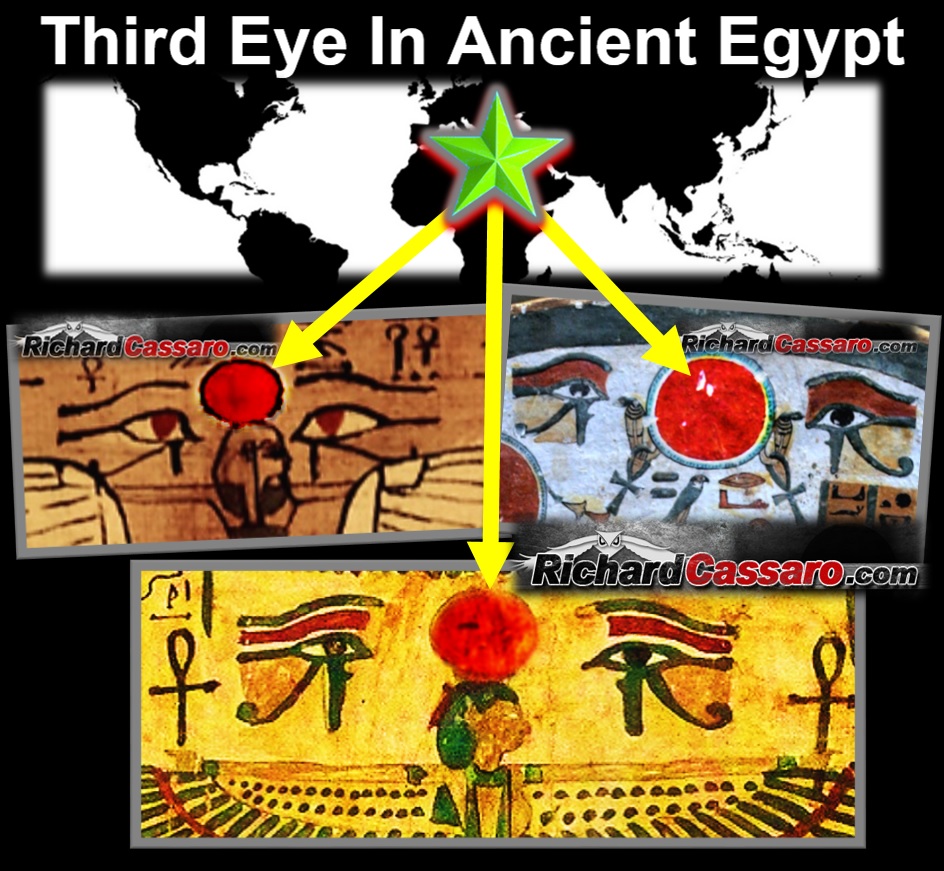
Egypt’s solar Aten symbol, centered between two eyes, forms the Third Eye. This is identical to Hinduism’s Third Eye “forehead dot.”
The overwhelming majority of Egyptologists seem to not be familiar with the details of the age-old Hindu tradition surrounding the Third Eye. It should, therefore, come as no surprise that they seem largely unaware of the Third Eye’s central importance in the Egyptian religion.
The Third Eye is a key concept in Hinduism’s Kundalini Yoga, which teaches initiates to “balance” or “unify” our lunar ida left-bodily side with our solar pingala right-bodily side.
This “balance” or “unity” of our twin opposing natures makes us whole again—just as the balance or unity of China’s twin opposing Yin and Yang halves completes the perfect circle.
This “balance” or “unity” also awakens a serpentine power, which rises up our spine (through seven invisible “chakras” or energy centers) and activates a Third Eye hidden in our foreheads.
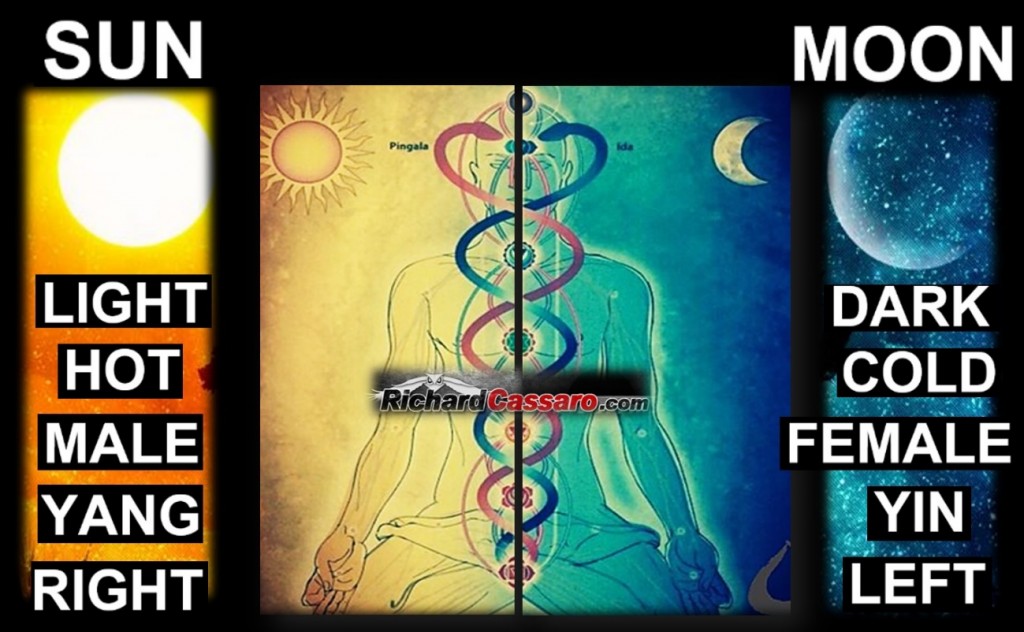
Kundalini ascending through the seven chakras, by “balancing” the “pairs of opposites,” symbolized by the sun and moon in equilibrium.
While many ancient cultures were still in their infancy, the Egyptians had already been creating mysterious images of a single Eye—the Third Eye—for centuries, if not millennia.
As we see here, the Eye symbol was carved into friezes, engraved on reliefs, sculpted into statues, and etched on papyri:

Egypt’s udjat Eye is identical to Hinduism´s Third Eye and Kundalini Yoga’s ajna chakra, which is still taught in India today.
The single Eye icon, known to the Egyptians as the udjat, represents one of the greatest mysteries of Egyptology. For years, its meaning perplexed me.
EGYPTOLOGIST DISCOVERS THIRD EYE IN EGYPT
I first learned of the theory that the udjat signifies Egypt’s Third Eye by reading the work of “rogue” Egyptologist R. A. Schwaller de Lubicz (referenced in John Anthony West’s book, Serpent In The Sky), who saw the Hindu Kundalini serpent in Egypt’s “serpent-on-the-forehead” motif:
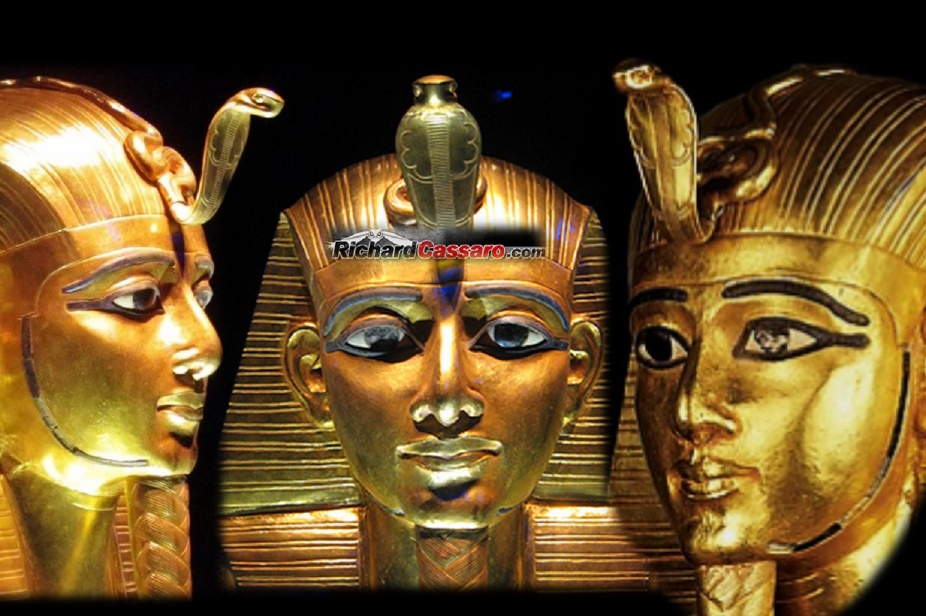
Egyptologist Schwaller de Lubicz saw the Hindu Kundalini serpent in Egypt’s “serpent-on-the-forehead.”
Hindus believe that enlightenment occurs when “serpent power” from the spine enters the brow. Normally, this enlightenment is represented in Hindu culture by an eye symbol on the forehead, representing the Third Eye.
I began some investigations of my own. My Eureka moment came when I found that some Egyptian sarcophagi depict a giant Eye on the forehead in the same position as the Third Eye:

Some Egyptian sarcophagi depict the Egyptian Eye (udjat) on the forehead, in the same position as the Third Eye.
I then realized that the Egyptians might have used exactly the same “forehead dot” as the Hindus to symbolize the Third Eye. As we can see in the images below, they did indeed.
In India the “forehead dot” is called Bindi. In Egypt, the forehead dot was called Aten, the sun symbol. The Egyptian “forehead dot” signifies the same Third Eye concept as the Hindu “forehead dot”:
These Egyptian images depict what in ancient and modern India is called Kundalini yoga’s ajna chakra or Third Eye chakra. Visual comparisons of images from both civilizations make this overwhelmingly clear.
As we can see, the Aten was often depicted as a Third Eye above and between the two eyes. The Aten was sometimes encapsulated inside the Shen symbol of “eternity”.
The Aten stands for the awakened Third Eye that sees the “soul within” or the “sun within,” and which “soul” or “sun” is really the “higher Self” or “divine spark” within us. The Aten is thus a symbol of both the Third Eye and the “Soul Within” that the awakened Third Eye sees. Only the most basic visual evidence has been presented thus far, and it overwhelmingly suggests that the Egyptians, like their Hindu contemporaries, believed in and practiced a spiritual custom hitherto considered strictly Hindu. The visual evidence also illustrates that the Third Eye concept was much broader in antiquity than that hitherto understood, or accepted, by scholars.
Notice how the idea of “balance” is conveyed in the following depictions of the Third Eye in Egyptian art, which show a perfect left-side/right-side equilibrium. In each example, a sushumna running down the middle reconciles the twin sides, and the sushumna is topped with the aten or shen symbol, which both symbolize the Third Eye:
Left: The “altered” images, which have been digitally altered to omit the sushumna down the middle and Third Eye on top. The left-side / right-side equilibrium, which signifies the “pairs of opposites,” stands out more clearly.
Right: The “authentic” images, where the sushumna is shown in the center, balancing and uniting the twin sides and awakening the Third Eye on top.
This left-side/right-side equilibrium or symmetry, which is more easily visible in the “altered” images shown on the left, hints at three things:
1 – The Egyptians understood duality.
2 – They understood that artistically this duality should visually take the form of “opposites in balance” (i.e., the right side “balanced” by the left).
3 – They placed, in the middle and at the pinnacle of these “opposites in balance,” a “centered” Third Eye image.
Just as the Yogic channels of ida and pingala must be balanced for the spiritual energy to ascend the spine, flood the skull, and awaken the Third Eye, the duality in these Egyptian images indicate a “balancing” of the left and right sides, to awaken the Middle Eye:
“The phenomenon of duality pervades Egyptian culture and is at the heart of the Egyptian concept of the universe itself. But rather than focusing on the essential differences between the two parts of a given pair, Egyptian thought may stress their complementary nature as a way of expressing the essential unity of existence through the alignment and harmonization of opposites…”
Here Dr. Wilkinson tells us that the ancient Egyptians believed in “duality” and the “harmonization of opposites.” These are nothing less than the basic foundational principles of Kundalini Yoga! In fact, Dr. Wilkinson´s description of the Egyptian worldview is parallel to a similar description of the Hindu worldview provided by Professor Joseph Campbell, who gave this description while describing the symbolism in the following ancient Hindu statue in Mumbai, India:
The statue forms a three-in-one design, with a male on the right (sun, light, hot, yang, Jachin), paired with a female on the left (moon, dark, cold, yin, Boaz), which together flank a main “god” in the center, which faces forward (the eternal, spiritual you).
Campbell interprets the statue for us:
“Whenever one moves out of the transcendent, one comes into a field of opposites. These two pairs of opposites come forth as male and female from the two sides. One has eaten of the tree of the knowledge, not only of good and evil, but of male and female, of right and wrong, of this and that, and light and dark. Everything in the field of time is dual…
The mask represents the middle, and the two represent the two opposites, and they always come in pairs. And put your mind in the middle…You’re in the field of time when you are man, and one of the problems of life is to live in the realization of both terms. That is to say, I know the center…”
So for years, even scholars have recognized a perfect link connecting Egypt and India, not just in the Third Eye symbolism that these two ancient empires shared, but also in the philosophy of actual “duality” and “transcendence of duality” behind Third Eye symbolism.
But besides these tomb paintings, what other evidence suggests that the Egyptians knew and understood the Doctrine of Duality and the Transcendence of Duality? What other evidence exists of the Third Eye in Egypt? The answer will astound you…
THE NILE – A RIVER OF RECONCILIATION
On a macro scale, the entire Egyptian empire formed a magical “balance of opposites”—a truth hidden in the geography of Egypt, and the actual flow of the River Nile. From time immemorial, the Nile has divided Egypt into a duality of “Two Lands”—so-called “Upper” and “Lower” Egypt. From Upper Egypt in the country’s South, the Nile flows downstream towards the Mediterranean Sea into Lower Egypt in the North.
Upper Egypt is called “upper” because the land is elevated and closer to the source of the Nile in the highlands. Lower Egypt refers to the marshy swamps in the lowlands, where the Nile flows into the Mediterranean.
The renowned author and screenwriter J.E. Manchip White writes:
“…Egypt is the River Nile. On each side…runs a narrow carpet of soil, which supports a teeming population…Lower Egypt is short and broad, Upper Egypt is long and narrow. The two divisions, or Two Lands, as the ancient Egyptians called them, are complementary.”
As White explains, the Egyptians themselves referred to Upper and Lower Egypt as “the Two Lands” or Tawi. Upper Egypt was signified by the Lotus, and Lower Egypt by the Papyrus:
More than just geographically separated, the Two Lands were politically at odds as well. During the pre-dynastic period, before Egyptian history had officially begun, the country was divided into two kingdoms:
-
Upper Egyptian Kingdom (Lotus).
-
Lower Egyptian Kingdom (Papyrus).
The line of kings who ruled in the North (Lower Egypt) had their capital at Botu and wore the so-called “Red” Crown. The line of kings who ruled in the South (Upper Egypt) had their capital at Nekhen and wore the “White” Crown:
According to Egyptologists, a ceaseless rivalry encompassed the Two Lands from time immemorial. Upper and Lower Egypt were bitter rivals, always in opposition and conflict—i.e. as if they were perfect opposites.
This is the doctrine of duality. All that is needed is the reconciliation power of the number “Three” to unite them.
RECONCILING THE TWO LANDS
In fact, the Two Lands of Upper and Lower Egypt did eventually reconcile, uniting into a single harmonious kingdom—the Egypt we celebrate today. Instead of fighting, the Two Lands joined to form one of the most enduring empires that the world has ever known. The late Egyptologist E. A. Wallis Budge explains:
“…There were kings reigning in both Upper and Lower Egypt about BC 5000…There must have been frequent fights between the South and the North, and the rivalry between the King of the South, and the King of the North, did not cease until Men, or Mena, the legendary Menes, a King of the South, vanquished the King of the North and united the two kingdoms under his rule. Probably this was not affected as the result of a single battle, but only after a long struggle which lasted for years.”
Around 3100 B.C. King Menes (sometimes called King “Narmer”) of the South vanquished the King of the North and united the “Two Lands.” This is considered the single most important event in Egyptian history.
Professor R.T. Rundle Clark (1909-1970), a Lecturer on Egyptian History and Language in the department of ancient history at Birmingham University in England, writes,
“Egypt was a union of two distinct regions, the Delta in the north and the Nile valley in the south, and the king was the reconciler of the two.”
Writing in the 1940s, Henri Frankfort, a professor of pre-classical antiquity at the University of London, explains that the unification of the Two Lands,
“…Expressed in political form the deeply rooted Egyptian tendency to understand the world…as a series of pairs of contrasts balanced in unchanging equilibrium…When Pharaoh assumed dualistic titles or called himself “Lord of the Two Lands,” he emphasized not the divided origin but the universality of his power. The dualistic forms of Egyptian kingship…embody the peculiarly Egyptian thought that a totality comprises opposites.”
Thus, we see in the political landscape surrounding the union of the Two Lands of ancient Egypt the esoteric doctrine of duality, and the reconciliation of opposites.
Narmer founded the capital city of Memphis precisely on the border between Upper and Lower Egypt. This laid the foundation for an era Egyptologists have dubbed the “First Dynasty” of kings, which followed in succession until the 30th Dynasty. Together all the dynasties comprise the history of ancient Egypt as we know it.
An Egyptian pharaoh soon became known as a “Lord of the Two Lands,” an appellation that continued until dynastic rule ended a few centuries after Jesus.

Egyptian Pharaohs soon became known as “Lord of the Two Lands,” an appellation that continued for thousands of years.
Narmer also combined the twin crowns of Upper and Lower Egypt into a single crown, called the “Double Crown” or Pschent. Symbolically, this act was a magical operation akin to the Yogic “balancing” of the Ida and Pingala channels, to awaken the Third Eye at the apex. It was like the uniting of Yin and Yang to create the perfect Tao circle.
“For most of… [Egypt’s] long history, pharaoh wore the double crown, combining the Red Crown of Lower (northern) Egypt and the White Crown of Upper (southern) Egypt.”
Turned on its side, this new “Double Crown” of unified Egypt bears a mysterious resemblance to Egypt’s udjat, or “single Eye” symbol:
This resemblance is uncanny. If this was intentional, the message is clear. Reconciling opposites (the Two Lands) opens the hidden Eye organ in the crown of the head. This idea is inherently logical because the “Double Crown” symbolizes a unity of duality (Two Lands), which is the way to awaken the Third Eye.
Support for this theory is evident in Egyptian friezes and sculptures. The following image appears in Egyptologist E. A. Wallis Budge’s Osiris & The Egyptian Resurrection I. Note the Eye protruding from Pharaoh’s head in the form of the “Double Crown”:
This image is said to be King Senka-Amen-Seken slaughtering his enemies. Rather than killing human foes, however, the word “enemies” may have signified inner demons. In this photo, the following two features express balanced duality:
- The black and white pattern formed by the prisoners’ headgear (like Masonry’s checkerboard floor.)
- Five prisoners facing one side, and five facing the other, in perfect symmetry.
Also note the triangular image within the prisoners’ skirts. Senka-Amen-Seken’s lance pierces that triangle’s apex. The triangle seems to be a clue – that the prisoners are in perfect balance. Also note the round eyeball drawn inside the “Double Crown”. This was not artistic license on the part of the artist for Budge’s book; that eyeball is evident on the actual reliefs, friezes, and stone carvings themselves.
Not long after Narmer, the hieroglyphic representation of a person’s windpipe—which means to unite—came to stand forevermore as the reconciliation of Upper and Lower Egypt, the union of the North and South:
A windpipe was chosen because the windpipe is vertically centered between “twin” lungs—a perfect “three-in-one” or “balance of opposites” symbol. This is interesting because in Kundalini Yoga the art of “finding our center” by “unifying opposites” is achieved by meditation and breath control.
The windpipe was usually decorated with hieroglyphs of the Papyrus and Lotus tied together on either side in unity:
This “Union of the Two Lands” hieroglyph is called Sema Tawy, and it’s a perfect symbol for the “Balance of Opposites” or “Unification of Opposites.” This, according to Egyptian teachings, is the Great Work we must all perform, in order to find our center, and to awaken our true divine Self.
Comparative religion scholar Alvin Boyd Kuhn, author of Lost Light, understood this spiritual dimension of the union of Upper and Lower Egypt quite well:
“Man’s sovereignty extends across both sides of life’s total area. He occupies the Two Lands, or Upper and Lower Egypt. And after long cycles it will be his prerogative to settle the aeonial warfare between these two provinces of his nature, reconcile them in harmony, and finally unify them under his single spiritual lordship. Straight and clear is Egypt’s proclamation of this sterling truth: “He cultivates the Two Lands; he pacifies the Two Lands; he unites the Two Lands… Spiritual and not political history is being recorded.”
There is little doubt that Kuhn is on to something when he suggests that the Egyptians came to see their own spiritual “opposites in balance” religion/philosophy personified in their own political history. I’ve long taken note that, while the Sema Tawy glyph portrays an image described by Egyptologists as the lungs/windpipe, it can also be seen as the pelvis/spine:
In this interpretation, the Sema Tawy depicts not just one, but two parts of the human anatomy: the “lungs/windpipe” and the “pelvis/spine” simultaneously.
Both are, as discussed, associated with Kundalini Yoga.
Viewed this way, and with the Lotus/Papyrus opposites attached on either side, this glyph depicts a roadmap and/or set of instructions to awakening our Third Eye, by balancing the right and left sides of our body through breath control, and by raising the sexual energy from our pelvic region up our spine, and towards our head.
This is precisely what’s being conveyed artistically by the perfect symmetry of the twin Hapi deities shown below, who are often depicted as flanking the Sema Tawy, and who mimic and reflect the symmetry of the Sema Tawy itself:
Together, twin beings tying the Sema Tawy signify “balanced duality,” which is why they’re depicted symmetrically, as “tying the knot,” in a kind of “alchemical marriage” of Male/Female, Right/Left, Light/Dark, and all the other pairs of opposites.
This theme was directly connected to Egypt’s Third Eye, as we’ve already seen. Sometimes the deities flanking the Sema Tawy were the gods Horus and Set, classic rivals (opposites) in Egyptian lore:
The tying of the Sema Tawy was a scene often depicted by the ancient Egyptians in their art. As we can see in the image below, the Sema Tawy was (purposely) aligned directly beneath the Aten or Third Eye symbol:
We’ve come full circle! We are back to the Aten depicted on top of each portrait.
Why is the Aten aligned directly above the Sema Tawy? The Aten is aligned directly above the Sema Tawy, because the Aten is the symbol of the Third Eye, which awakens when we “balance” or “harmonize” the Two Lands of Upper and Lower Egypt—the very idea being expressed by the “tying” of the Sema Tawy!
It is almost unimaginable, once we’ve understood these profound truths of the Egyptian religion, to think of going back into Plato’s cave to read the accounts of mainstream Western Egyptologists, many of whom see this scene as simply a depiction of the pharaoh sitting on his throne of Upper and Lower Egypt while getting a nice tan beneath the midday sun. Such a tone was set by the late-19th century professor of Egyptology at the University of Berlin and director of the Egyptian Department at the Royal Museum, Adolf Erman, who pioneered the systematic study of Egyptian grammar:
“In fact, it was not the sun-god who was adored, but the material sun itself…”
Keeper of the Oriental Department of the British Museum for 30 years, one of the foremost British Egyptologists of the early 20th century and a widely recognized, leading writer on the subject of Egyptian religion Sir Ernest Alfred Thompson Wallis Budge, was one of the few scholars enlightened enough to recognize indigenous African influence in Egyptian religious practices. But even Budge fell captive to the idea that Egypt’s main significance lay in its status as forerunner to Christianity and Islam:
“From one point of view the Egyptians were from first to last monotheists, and their One God was the Sun. The monotheism of the Egyptians may even be compared to that of the Hebrews and Arabs. The Hebrews proclaimed Yahweh to be One…The Muhamaddans say Allah is One…”
For all the mummy, tomb and manuscript discoveries trumpeted by the likes of the long-time Egyptian Antiquities Minister Zahi Hawass, the conventional view of Egyptian religion has not changed much in over a century. In 2001, Stephen Quirke, an Egyptian manuscript specialist and curator at the Petrie Museum of Egyptian Archaeology, University College London, published a book titled The Cult of Ra: Sun Worship in Ancient Egypt, in which he explains how:
“Egyptians expressed the world as physical matter unfurling from the sun.”
This conventional explanation of Egypt as a sun-worshipping culture that laid the foundation for more “advanced” monotheistic religions has stubborn roots. Since Egyptian civilization paved the way for Western culture, the argument goes that its religion must be in some meaningful way consistent with Christian and Islamic teachings. Hogwash! In my opinion, this attempt to explain the past by saying it contained the seeds of the future makes no sense; this is yet another example of the arrogance of Western imperialist and Orientalist dogma. These Oxford dons and TV stars falsely claim the title of dispassionate scholar; they are more like the winning generals who write the one-sided history of the war in which they triumphed. In their haste to make Egyptian religion into the venerable ancestor of Islamic and Christian beliefs, with the place of the Sun-God Ra taken over by the monotheistic external God, mainstream Egyptologists have missed almost everything important about Egyptian religious practices!
In the Abydos bas relief pictured above, Pharaoh is depicted as the master of all duality and the perfect “model” for every citizen of Egypt who wishes to “harmonize” or “transcend” his or her own opposites. And yet the scene is telling us even more than this…
The scene is telling us that all of Egypt – the entirety of the nation itself – is laid out upon the same principles of “harmony” and the “balance of opposites” on which the Universe is laid out (maat). The scene tells us that in order to balance our own lives, we must live in a way that is in harmony with the Universe.By aligning their monuments to astronomical events like the solstices and equinoxes, the Egyptians (and the ancients in general) were pulling that heavenly harmony down to earth and into their own lives. They knew that old astrological Wisdom Teaching that “Man is the Microcosm” and the “Universe is the Macrocosm” and they certainly practiced the concept of “As Above, So Below” by aligning their monuments astronomically.Perhaps more interestingly, they also knew something more about this Wisdom Teaching that few people today understand: “As Inside, So Outside.”
The world we see on the “outside” is but an echo or reflection of the world that exists “inside” ourselves. Conflicts or problems that appear “outwardly” in our lives are real-world manifestations of inner imperfections. Problems, then, are not really problems, but symptoms that manifest outwardly, telling us where to focus our attention – inward – in our continuing engagement in the Great Work.
By showing scenes like that of Sechat at Abydos, the Egyptians were hoping to influence the interior world; the inner world; the world within themselves—like a mandala. By creating a kingdom of balanced duality on the outside world, they were trying to mimic the conditions that they sought within themselves.
This is the secret of seeing with the Third Eye.
Thus we can see that everything – all of existence – is neatly expressed in this simple Aten symbol, which ultimately signifies the soul:
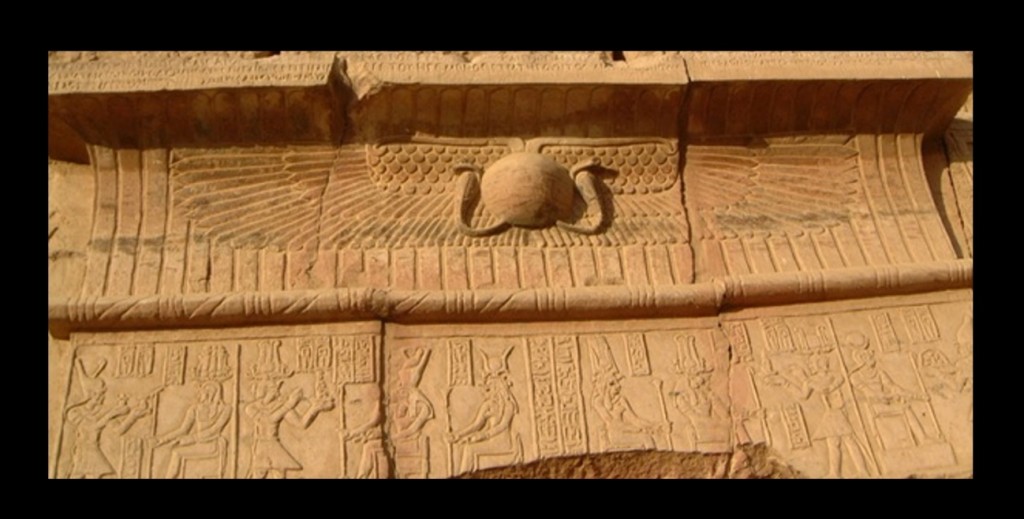
The “circular” Aten or ”Sundisk” symbolizes the “soul within.” The circle, with no beginning and no end, always symbolizes eternity and things eternal.
Twin serpents issue from the Aten. They denote “duality,” the pairs of opposites. Of equal size and parallel shape, the serpents face opposite directions, signifying their “corresponding yet contrary” natures:
The twin serpents were often depicted wearing the White and Red Crowns of Upper and Lower Egypt, showing us that Egypt’s Aten perfectly parallels China’s Taijitu or Yin/Yang symbol:
The serpent of Upper Egypt, wearing the White Crown, parallels Yang. The serpent of Lower Egypt, wearing the Red Crown, parallels Yin.
And just as Yin and Yang are encompassed by the Tao circle of eternity, so the Aten circle organizes Egypt’s twin serpents into a higher unity, balancing them in perfect equilibrium.
The Aten was thus much more than the sun in the sky. The Aten was the eternal principle inside every human being— the “god within” us – our eternal higher Self. It was also the Third Eye on the forehead, which, when awakened, sees this higher Self or divine spark within:
In addition to being depicted on the Egyptian forehead, the Aten always crowned the facades of Egypt’s Triptych Temples.
A Triptych Temple is a temple with three main doorways or apertures, with the doorway in the center slightly taller or wider than the twin doors or apertures flanking it. Triptych Temples were built by all the pyramid cultures, including the Egyptians.Note the Aten symbol crowning the center door of these three Triptych Temples:
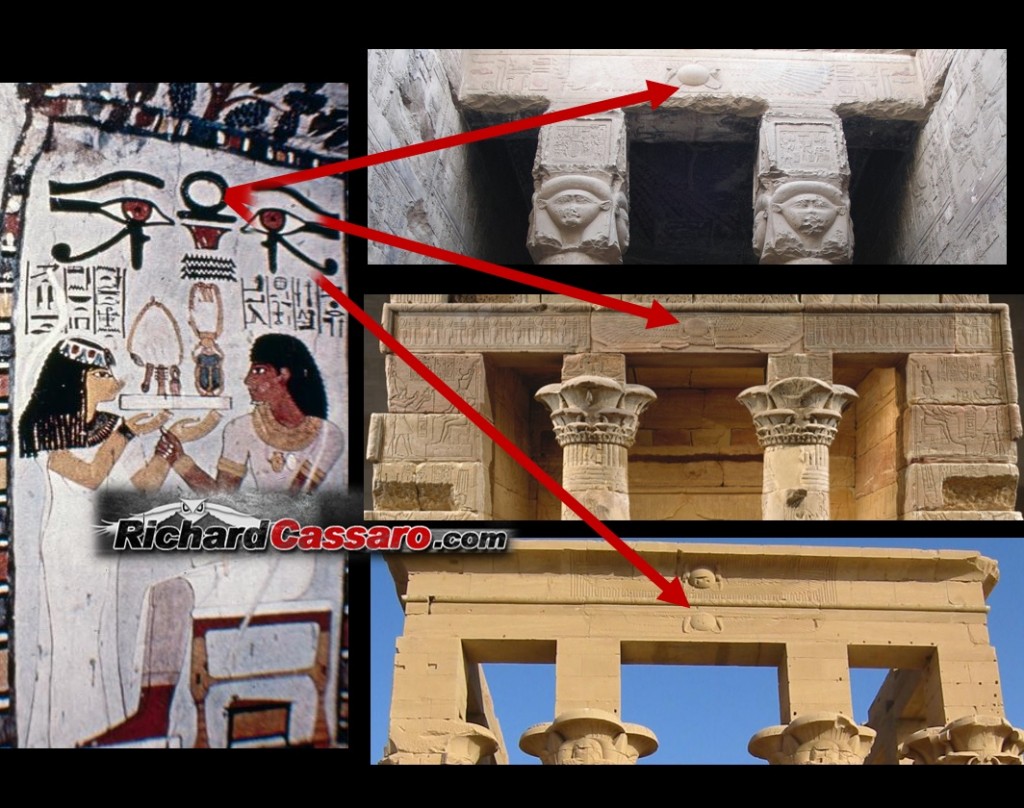
Egypt’s Triptych Temples with the Aten (Third Eye) crowning the center doorway. It’s not hard to envision these as temples dedicated to Third Eye awakenings.
Just as the Sema Tawy depicts “transcendence of opposites” via the “middle path,” so these Triptych Temples symbolically depict twin opposite windows or doorways flanking a centered “sun-door.”
The twin serpents match the twin outer doorways, and the Aten’s circle matches the centered door. The middle door is centered and enlarged, revealing its higher importance.To those of us who have a basic knowledge of yoga, these Third Eye representations are so pervasive in Egyptian symbolism that any denial or minimizing of this fact seems like a deliberate cover-up.
This appears to be happening in academic circles, considering discussion of the Third Eye in Egypt stretches back more than a century. It started with Madame Helena Blavatsky and her acolytes, who were among the first to nail down this connection. René Schwaller de Lubicz and his wife Isha made practically a life’s work on this very subject, and Manly Hall discussed it in his research. Edgar Cayce also gave readings linking Kundalini yoga and Egyptian Third Eye practice. In recent years, authors John Anthony West, Gary Osborn, and Drunvalo Melchizedek have embraced this tradition.
My work stands apart in that I’ve been able to connect the Third Eye in Egypt to a wider and older narrative: how the Third Eye in Egypt was a “local” version of a Universal “Third Eye” religion that was once shared worldwide by all of the pyramid cultures of Antiquity. I’ve also shown that the “Third Eye” religion was conveyed by pyramid cultures architecturally, using the three-door Triptych Temple:
There is more: after the rise of Christianity, this Triptych Temple and Third Eye wisdom was forced underground in the West. Secret Societies were formed to perpetuate Third Eye wisdom during an era when pagan traditions were outlawed, and any transgression meant certain death by the Inquisition. The Triptych Temple design thus became the perfect symbol of all Secret Societies; it was an emblem of rebellion against the Church, and also a vivid, living image of the “great secret” of the Universal Religion itself, which members of these Secret Societies once understood:
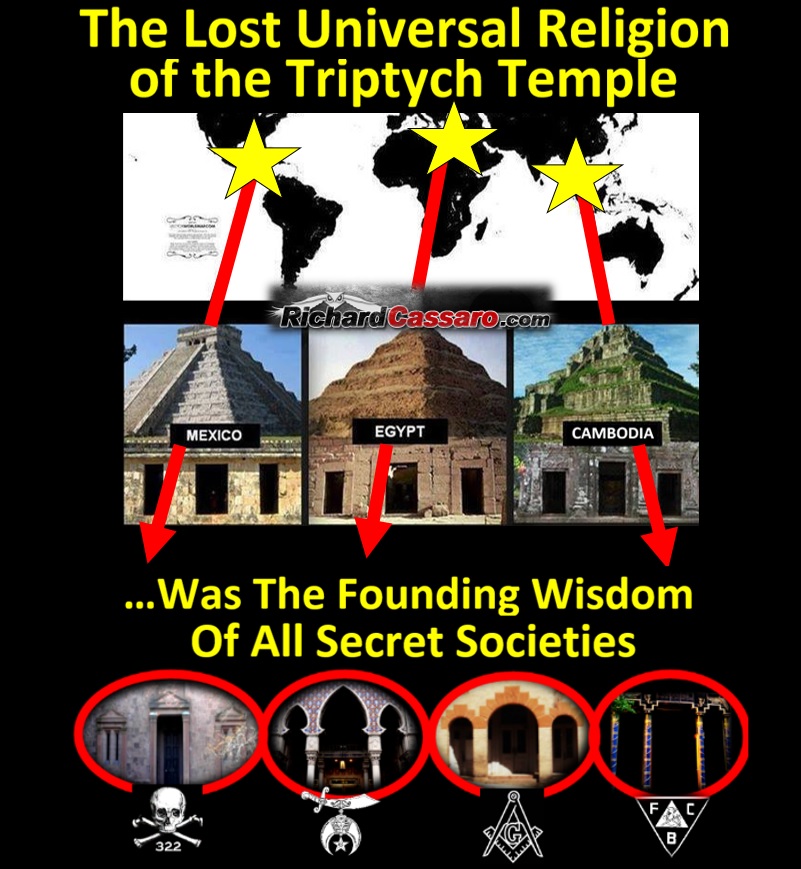
This evidence, linking Secret Societies to an ancient Universal Religion, is fleshed-out in greater depth in Written In Stone.
Within this article, I have limited myself to pointing out matter-of-factly, with the use of solid photographic evidence and iconographical explication, that much of Egyptian religion and Hindu practice is identical. Studying Sanskrit and Hindu Philosophy would, therefore, be an invaluable way of coming to grips with the true nature of Egyptian religion, rather than focusing mainly on making sense of the Book of the Dead.
Third Eye worship in Egypt is real. It seems to me that Egyptologists are ignoring an elephant in every wall painting, every papyrus scroll, and every monolithic work of architecture.
Ironically, it’s for precisely this reason that few Egyptologists see true insight and human wisdom in the Egyptian religion. In their view, Egyptian deities, myths and symbols are all external; signifying another person, place or thing, rather than for what they truly are—internal, symbolic of our own lives, our own destinies, and our own human condition. Applied properly, it’s this internal method that will allow us to decipher the symbols and iconography of Egypt and apply its wisdom to our own lives.
The outdated idea that the Egyptians were “sun worshippers” (in the sense that modern Egyptology supposes) should be discarded. The Aten was a symbol of the Third Eye in Egypt and the soul within us that the awakened Third Eye sees.
This is the great secret of the ancient Egyptian religion.






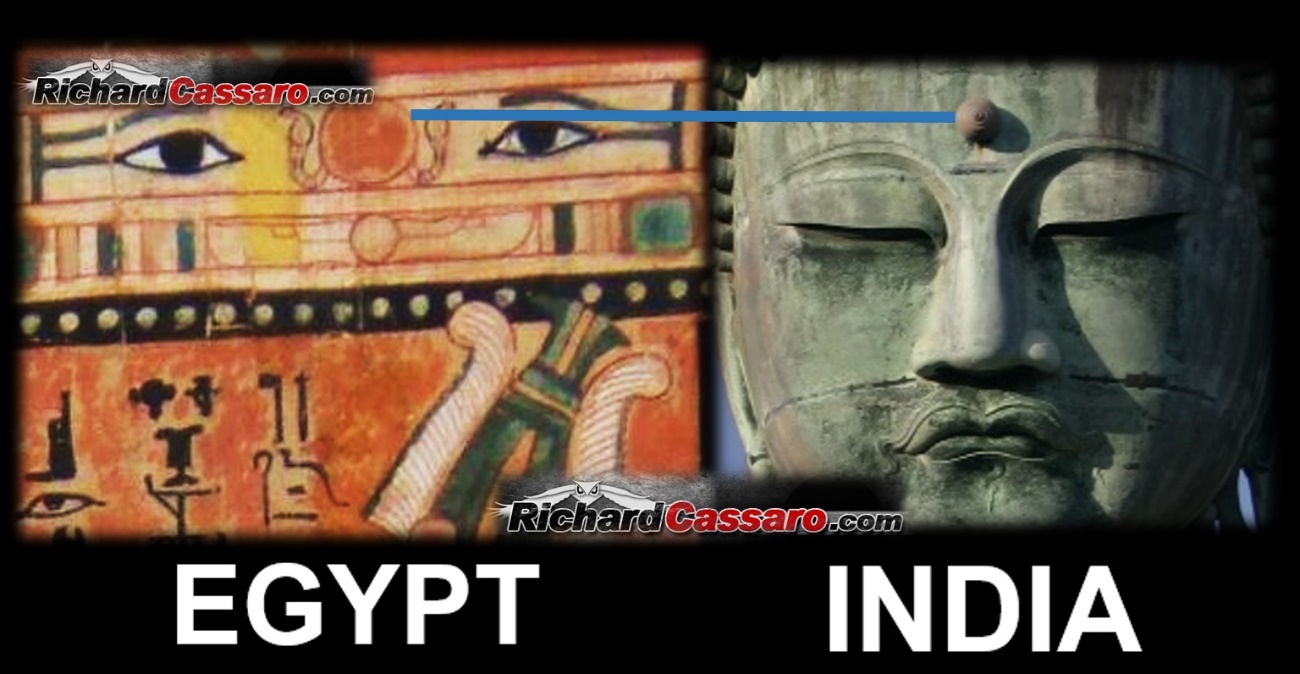


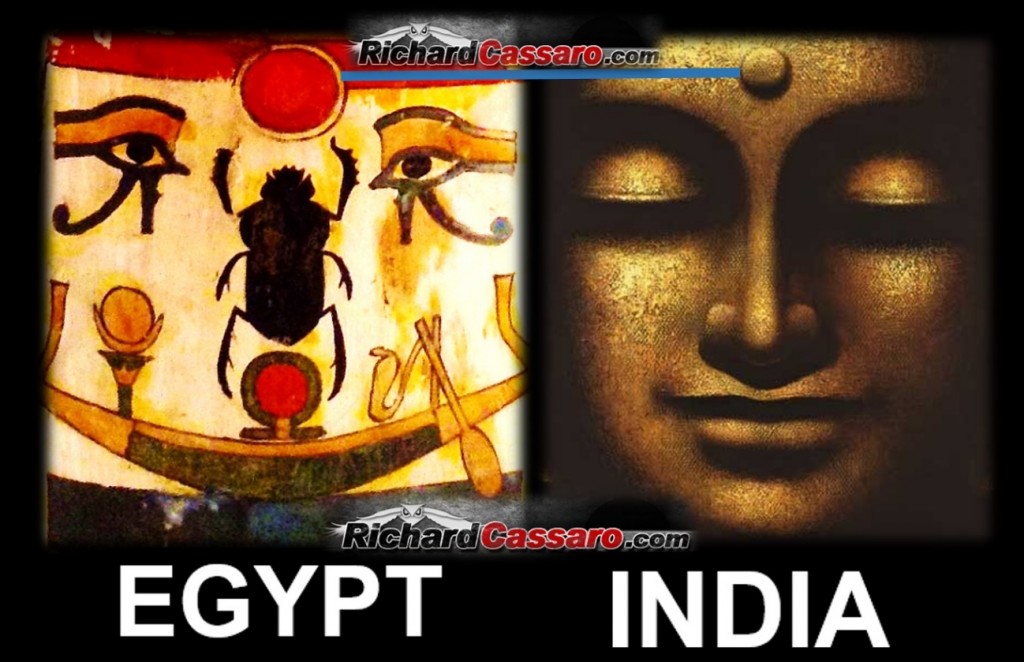
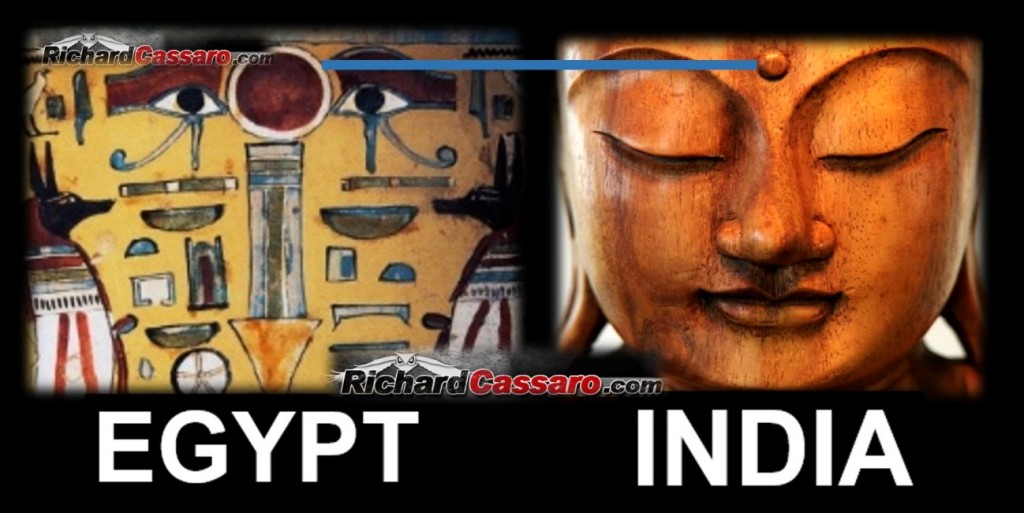

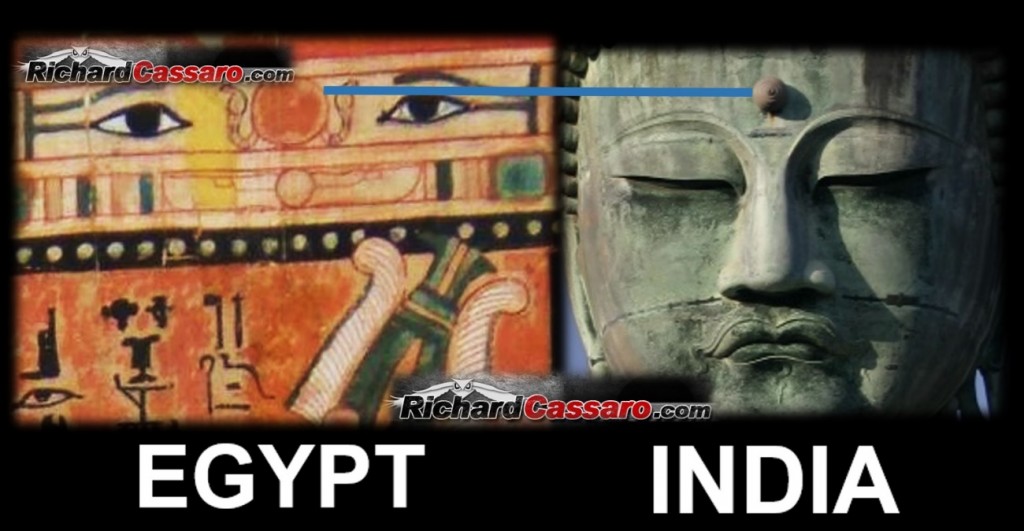
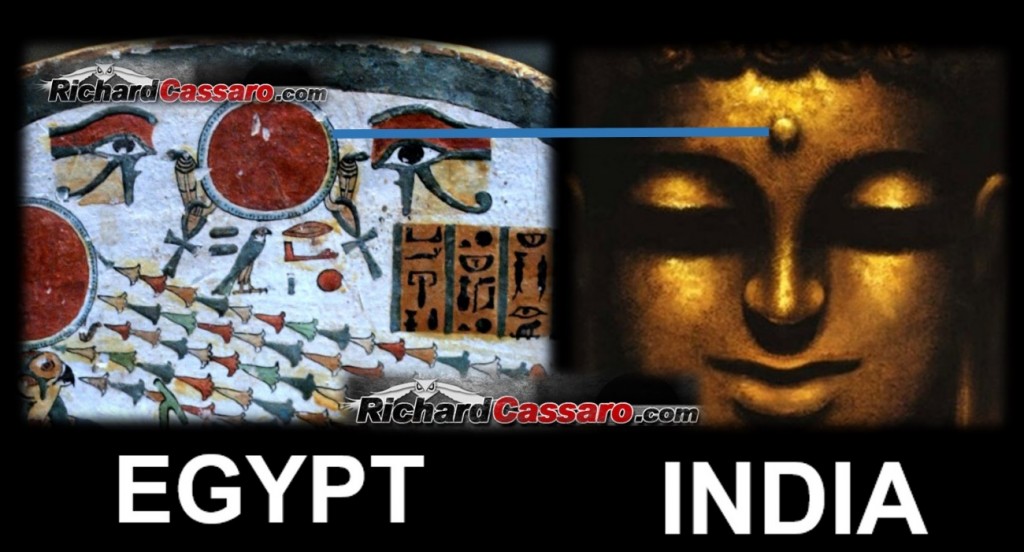





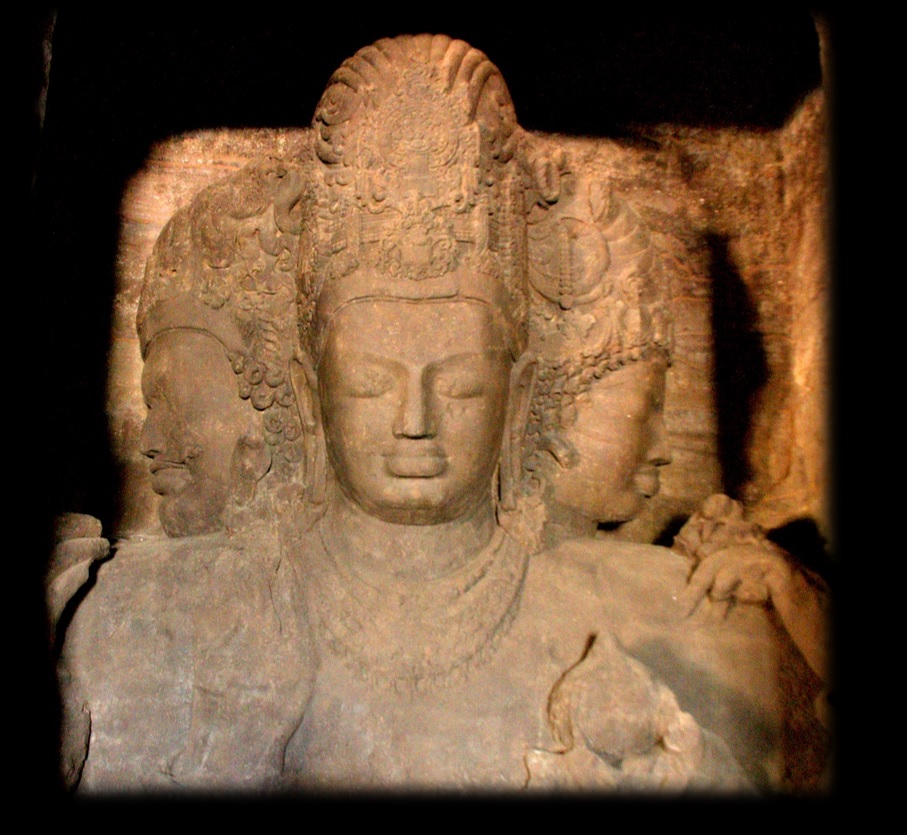
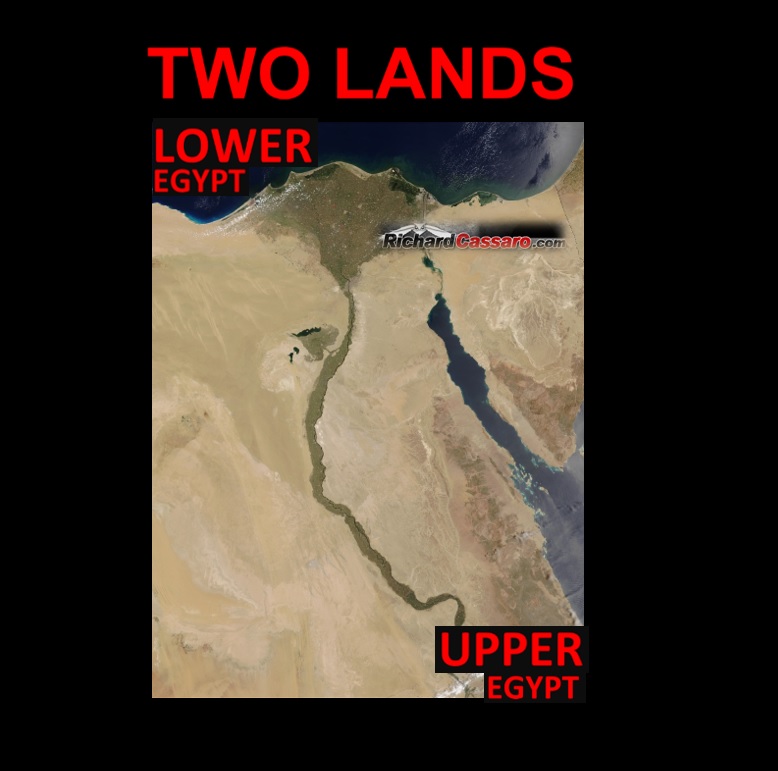
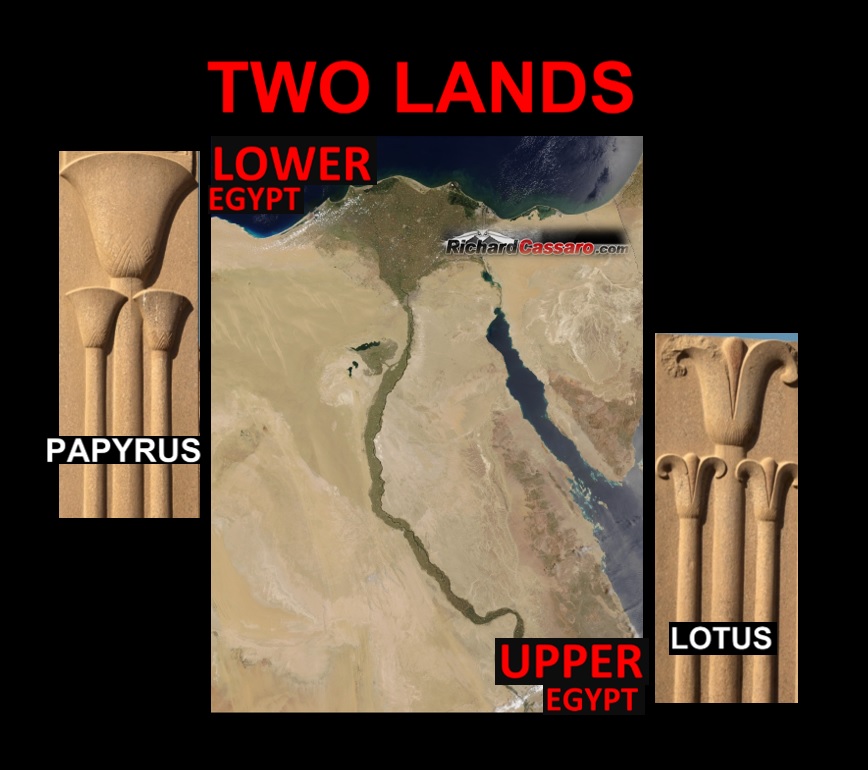
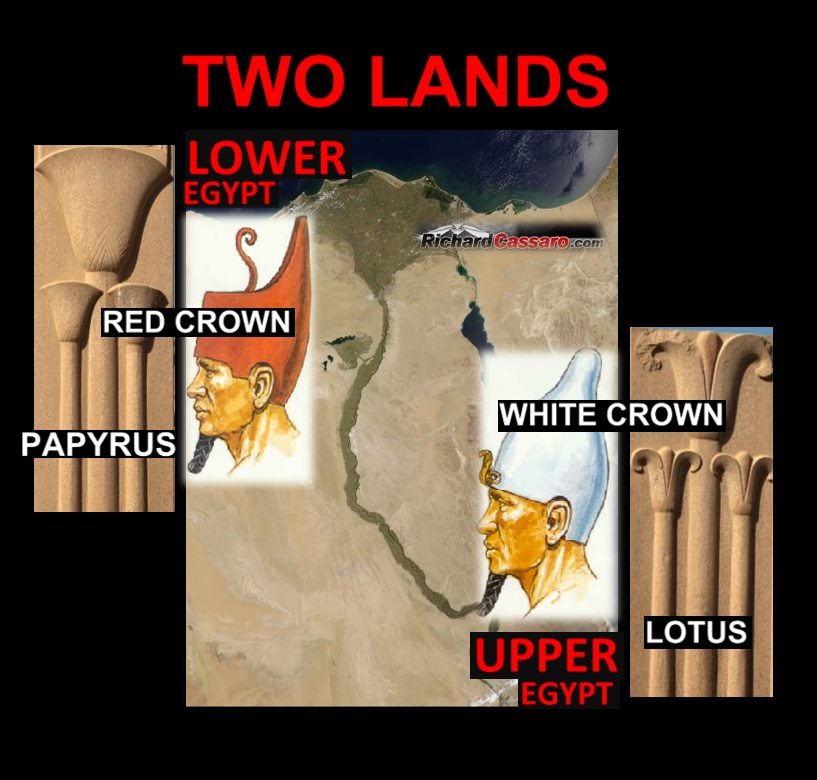
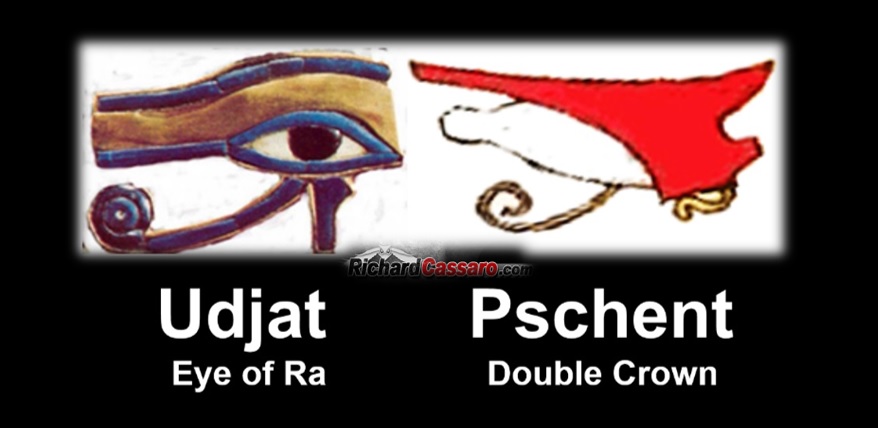


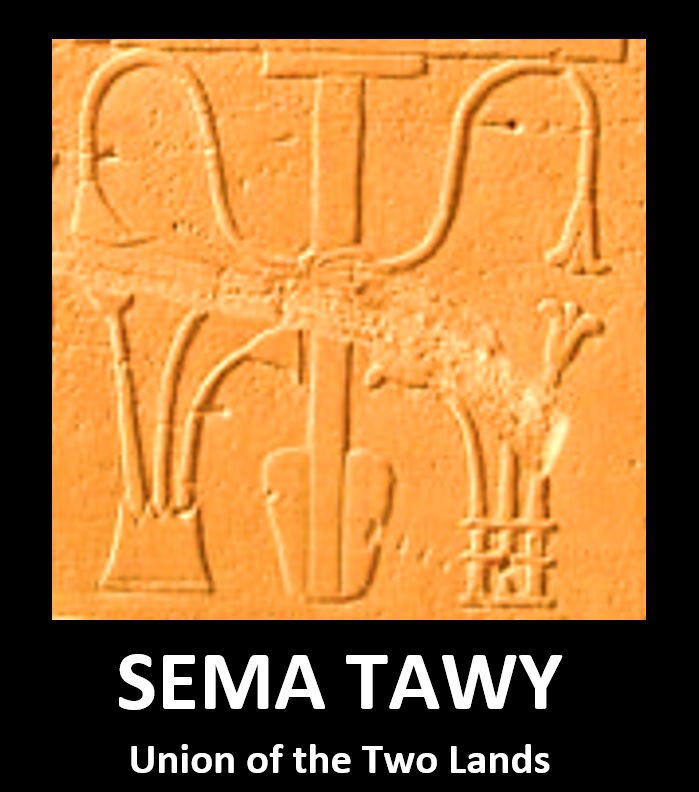
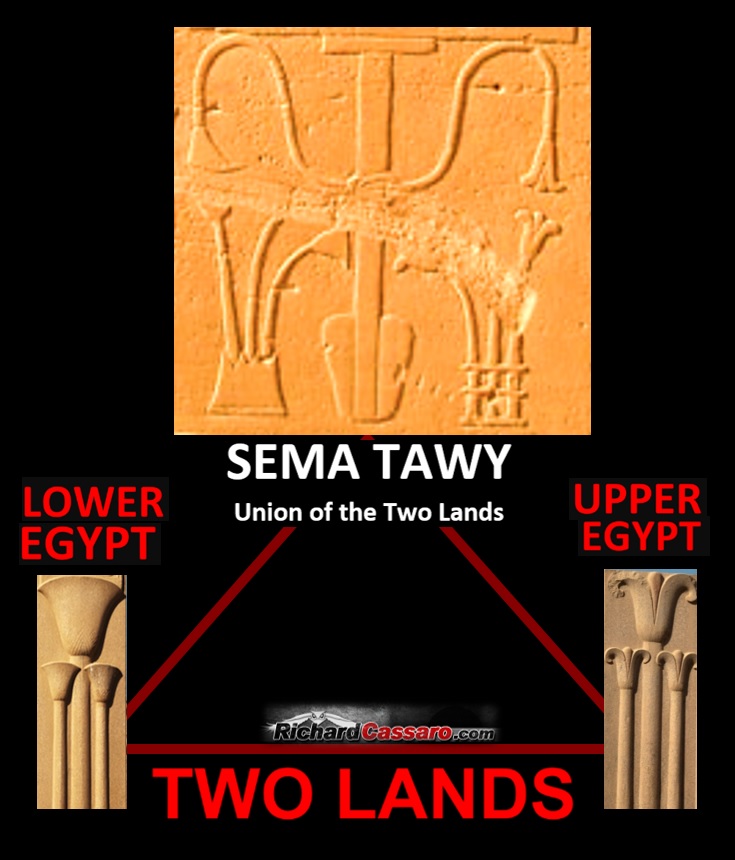
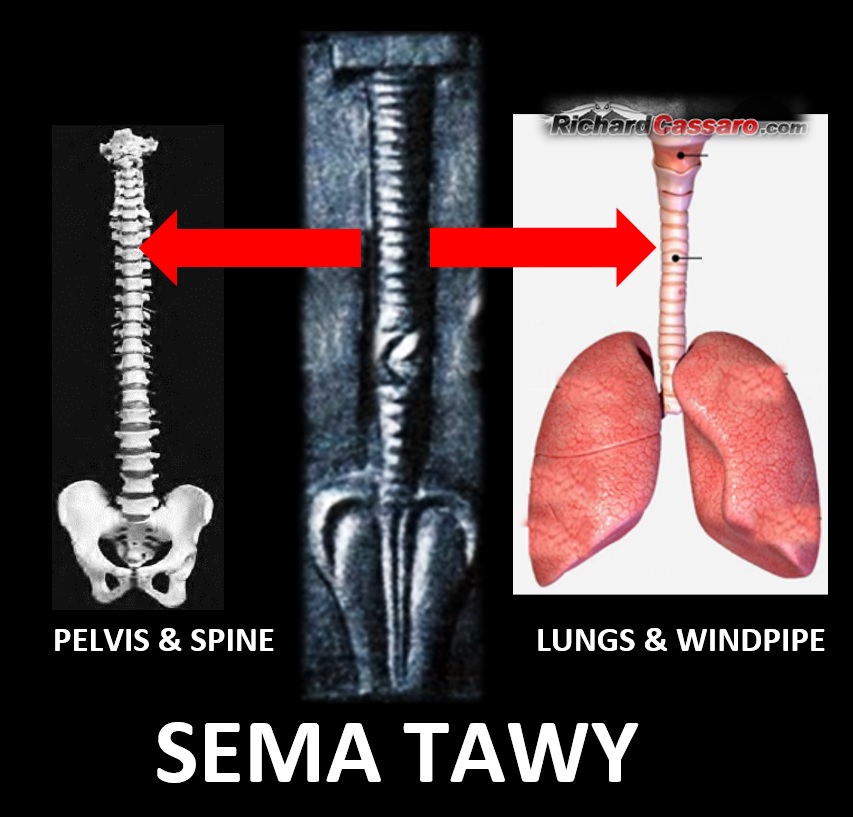
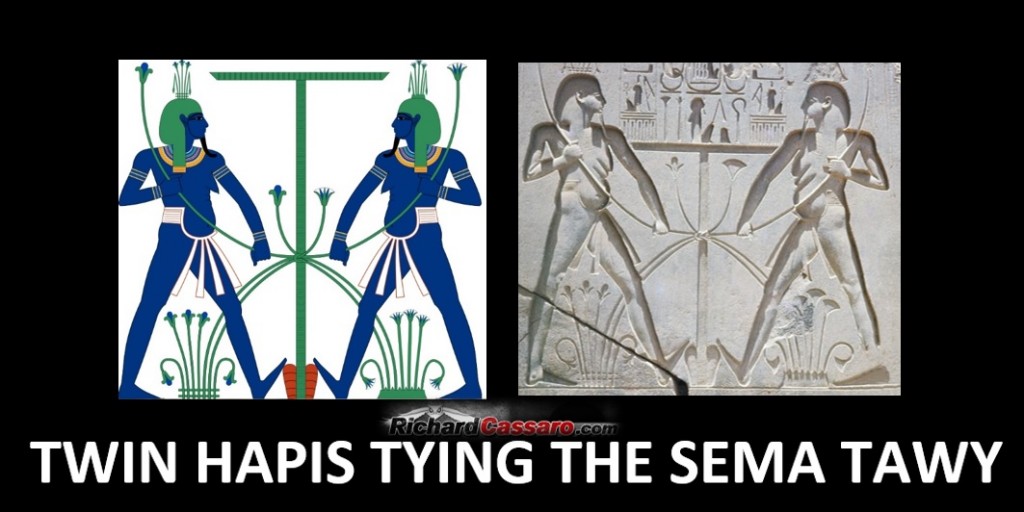
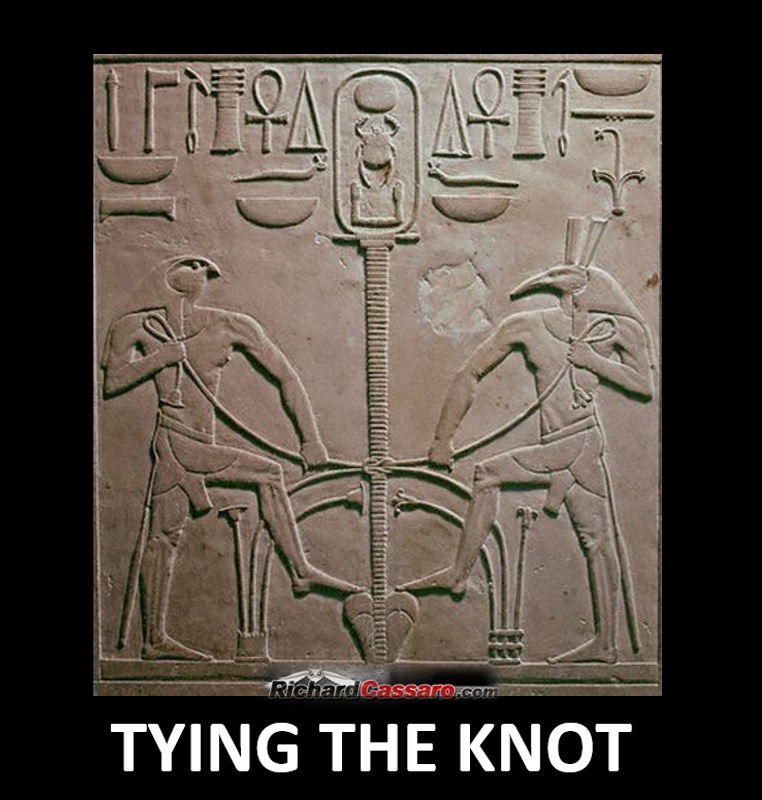

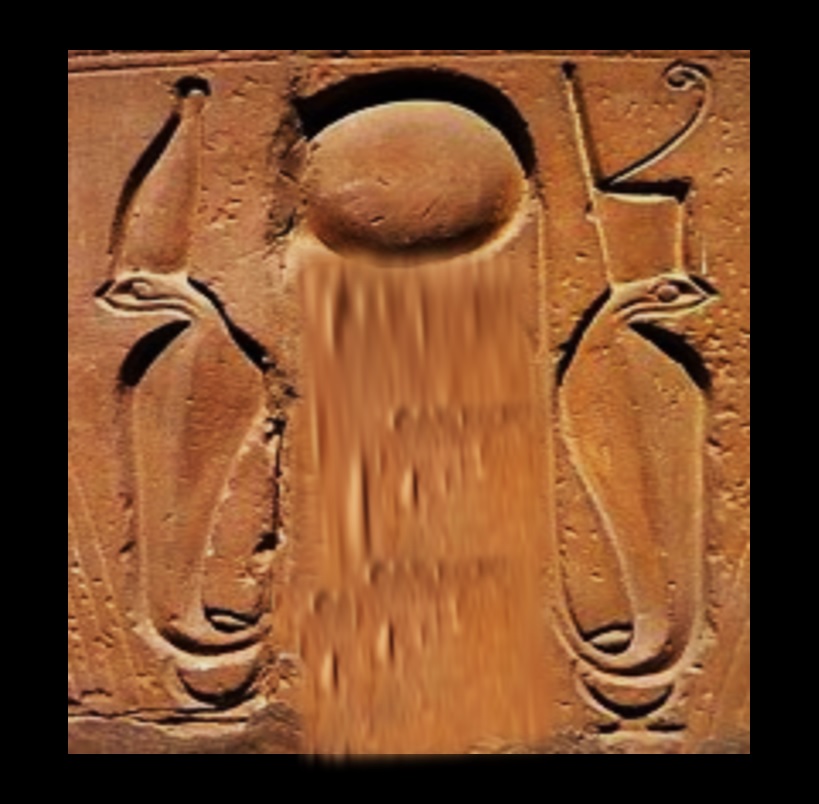
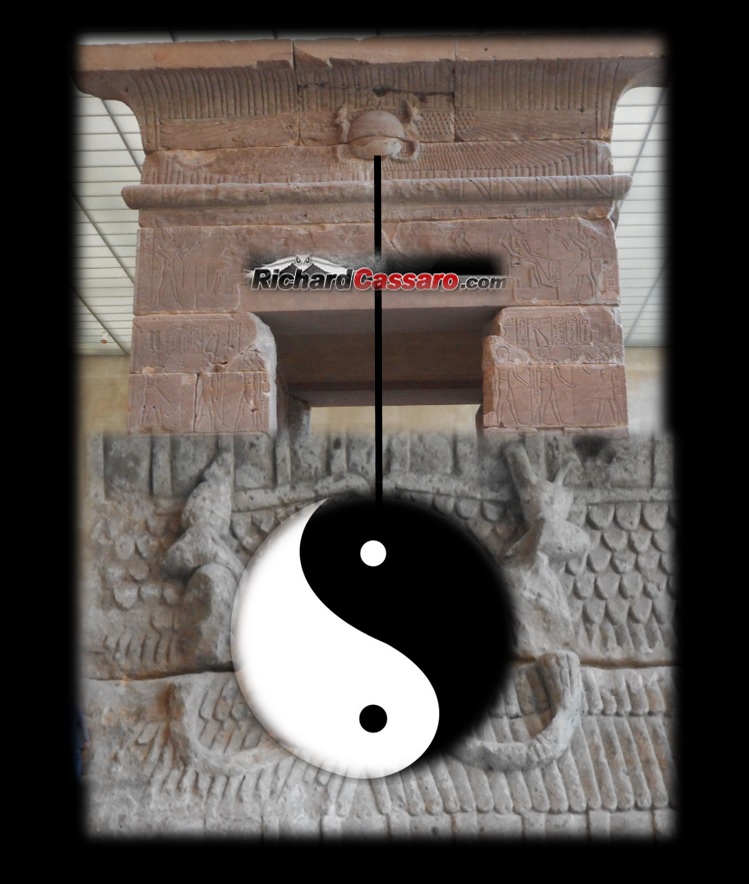


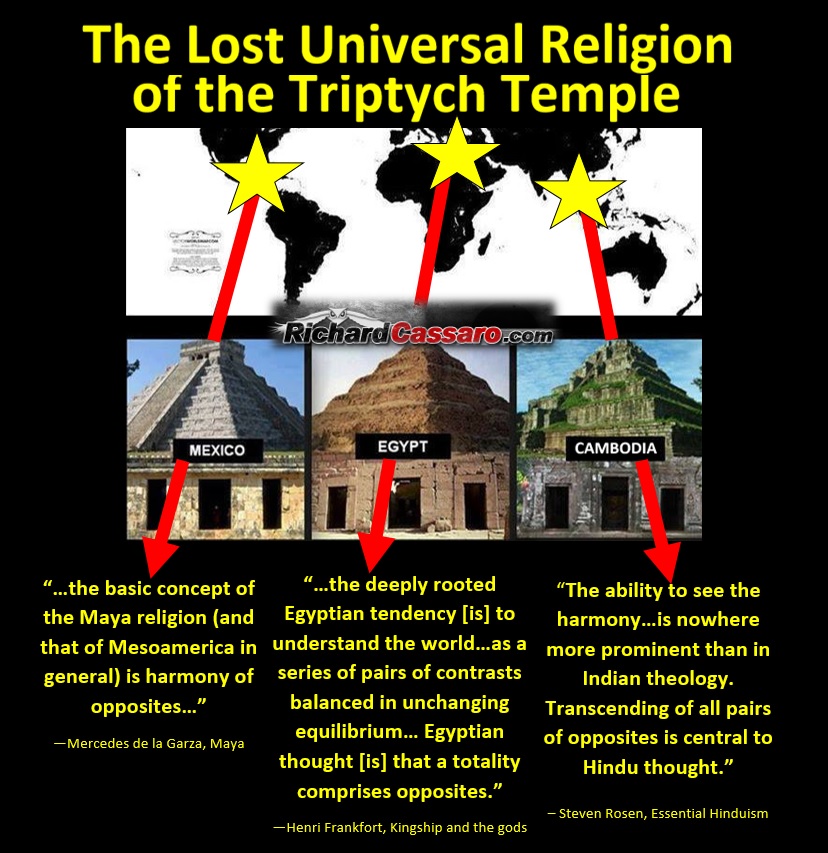
http://beforeitsnews.com/beyond-science/2013/01/secrets-of-the-third-eye-the-eye-of-horus-beyond-the-illuminati-2440634.html
Thank you, Florian.
Fascinating, and to the initiated, so obvious. Great article, thanks for publishing this.
Thanks for your kind comments, Christine. I think you said it perfectly. I agree exactly.
Hi Graham, I’m a huge fan. I’ve been following your work ever since Sign and the Seal. Anyway, when I saw the Triptych temple graphic, I immediately wondered if there might be a fourth site somewhere in the middle of Syberia or Mongolia. Why? It reminded me of a graphic in Fingerprints that depicted Orion’s Belt overlaid on the Giza plato. Maybe it’s far fetched, but I would love to hear what you think about it. Best wishes!
Thanks for your comment, Brian. I created that collage of Triptych Temples that you´re referring to, and the sites I included were chosen completely at random.
Great information, balance of the scale is certainly a common idealism and belief in modern and ancient cultures and societies, i.e.Statue of Liberty.
If I may add, in my experiences during meditation or altered states of consciousness, when my eyes are closed the inner visual observations are centered between the eyes or center of the forehead. Thus we are having a visual experience through a third eye by looking inside ourselves, and these experiences or visualization are as real to our brain as any other eyes open experience.
Thanks for your comment. I totally agree. The Third Eye is all about the journey inward, finding the center within, which center is who you really are.
Just blown away with this email, can’t wait to study the data. Thanks !
Thanks, Tore, for sharing your interest and enthusiasm.
Richard Cassaro, I have always enjoyed your work and I agree that the Pineal Gland coincides with the symbolism of the Triptych. I think you should also look at the concept of the Vesica Piscis in this regard.
This very concept of the Vesica Piscis (Triptych) is embedded in the first word of Genesis: BERESHITH. BERESHITH literally writes the first two verses of Genesis, which shows ELOHYM separating the Heavens and the Earth. A breakdown of the Gematria value of the letters in ELOHYM exudes the formula for pi: 3.1415. This extrapolates out into the whole of the first chapter of Genesis where the 32-uses of the word ELOHYM construct the sacred geometry of the Kabbalistic Tree of Life. What happens is that the 32-Elohym are split into two halves forming the central aspects of Vesica Piscis: one half is LIGHT and the other half is DARKNESS and ELOHYM is literally the diameter of that cycle of 32-Elohym https://www.facebook.com/photo.php?fbid=969963999709681&set=pb.100000882709141.-2207520000.1456440398.&type=3&theater Study the mathematics of this image of 32-Elohyms and you’ll see.
What I believe the Triptych concept boils down to and all the symbolism in the world that relate to it is the two-part psyche: i.e. Ego-consciousness (Sun – Boaz) and the Unconscious Mind (Moon – Jachin) and when this two-part psyche combines spiritually Christ consciousness manifest in the flesh (third eye is awakened).
Keep up the good work.
Thank you, William, for your kind words about my work and for sharing this very interesting material, which resonates with my views. I am excited to take a closer look at this, and I will inbox you with questions or comments. In response to your comment on the Triptych, you are definitely familiar with the symbolism, and I like your interpretation, but I explain the meaning of the Triptych a bit differently in Written In Stone. Looking forward to checking out your material, and thanks again.
Brilliant!
Thank you, Jennie!
Dear Richard, how comforting it is to read such Wisdom and Acknowledgment coming from you. How rich is your life and how wonderful you are to share all this with us.
To read this article in the morning is a real Balm that enlightens my day.
Thank you Richard.
Thank you, Maryse, that´s so nice of you to say. I´m really happy to know that you´re connecting with the material, and thank you so much for your very kind and uplifting words. I really appreciate it!
Dear Richard,
It almost seems that something is affixed to forehead that turns on our balance. I see bands and tops on Pharaoh head, even the Hindu Bindi is raised and placed on the forehead. What can be placed there to take oneself beyond duality? Maybe a insect, something long overlooked.
In my Yoga practice, I never enjoyed the breathing exercises; however, your section from Written in Stone above opened a new understanding. I’ll focus on balancing-calming the dualistic narrative.
I very much enjoyed Written in Stone! I’d love to have a electronic version. Can you tell where I can purchase a copy for my smart device. Thanks!
Best regards,
Craig
Thanks so much, Craig, for your kind words about my book. I really appreciate it very much. Written In Stone is not available in electronic format right now. I´m sorry about that. This might change in the future. You raise an interesting point about an insect on the forehead. I´ve seen the owl symbol on the forehead in Peru, and as we know Egypt´s Pharaohs also wore animals on the forehead. I´ve seen this motif in a few other places as well. With regards your Yoga, please let me know how it turns out. Non-duality is a very interesting topic, very profound. There are so many ways we can use it in our lives. I´ve been studying it for many years, and still I feel I´ve only scratched the surface.
Nice article from a great man. Personally, I move from a very practical understanding of the alchemical practices of Indian tantra and yoga – I have to agree that the Indian and Egyptian understanding is similar in many ways. What I find fascinating are some of the initiations and practices the Egyptians must have used. I’d be really interested to know of any practical means you may know of from the Egyptian traditions – I’d be happy to share my understanding and practice from the Indian tantra yogic schools.
Thank you for your kind words, Omkar. Please inbox me on Facebook. I can show you a few photos that I´ve marked up with text that you might find interesting. Also, I´d like to see whatever text or photos you care to show me. Looking forward to it, thanks.
Rich, could you clarify your view on conscious versus subconscious expressions.
On the shape and symbolism of the udjat eye, compared to the double crown, you write; “If this was intentional, the message is clear.”
If these icons were consciously designed, they were symbols, that some Egyptians could fully explain, and most members of other cultures could not.
If they arose or were borrowed from a prior culture spontaneously, and became conventions due to logical recognition, they are archetypes that rose to symbolism.
If they arose spontaneously, and became conventions due to instinctive recognition, and due to perpetual re-expression by generations of artists and users, they are archetypal shapes, and subconscious, which some Egyptians, and some of us, could only partly explain.
If near identical icons, in near identical contexts, are found in all cultures, that confirms their archetypal status.
I believe the latter is the case, with the udjat /third eye /double crown /glands /etc.
The ‘etc’ includes a long list of variant expressions of the same archetype, which I have found to be a set of sixteen distinctive clusters of shape /posture /species /functions organs /etc, among which intervene eight structural points analogous to limb joints, all 24 of which could be mapped on three ‘equators’, around a group of three ‘poles’, analogous to a cosmic map.
The udjat /third eye with its attached ‘limb joints’ /fractions, is not one of the sixteen main types, not one of the eight structural points, and certainly one, or all three, of the ‘poles’.
The Egyptian ‘knot of eternity’ hieroglyph that often appears with or around the udjat, I have identified as a subconscious expression of the celestial pole, including its adjustable diameter to account for obliquity. The frequent role of the scarab hieroglyph (type t14 Cancer) at the pole, is one of its archetypal roles (Greek myth identifies it as one of the soul gates to heaven; rock art and spiritual art worldwide shows it usually ingressed towards the poles much more than figures expressing other types). Clearly even this first level of cosmic analogy is too complicated for any culture or artistic programme or school to sustain for centuries. Consider the interplay between the three poles in astronomy, and the complexity of the optional attributes of the types, that appear at set average frequencies worldwide, and it is confirmed that no global committee or secret society could sustain the intricacies of cultural expression. We inherit some of it, but every culture has gifted artists, mythographers, ritualists, and iconographers (such as you and I) who recycle and re-express some of the correspondences. Those artists and theologists and esotericists (such as almost all of us on this website) who do not have knowledge of glands, could not know that nature imprints the archetypal tupos also there. Those of us who do not visualise numbers, could not appreciate the numerological complexities of the double crown etc. Those of use who are not astronomers could not use the myth map in the sky.
And those who are entirely caught up in the arrogance of science, and blind to esoterica, view the udjat either as conservative superstition, or as encrypted science. You seem to follow the latter approach. If so, you are in good company with Prof Giorgio De Santillana who read Icelandic myth as coded astronomy to record some details of precession and obliquity, that became degraded. And with one of my heroes, Claude Levi-Strauss, who read the ‘totems’ of ‘primitive’ minds as if they were conscious ‘messages’, or externalised philosophy. I support your view that we must look inward for the meaning of outward icons. Just go one step further, and recognise that the greater part of our ‘inward’ is normally out of reach to our mediating consciousness, and out of reach of our limited language, and the very limited functions of our conscious perception and expression. We have not stopped using icons, or rather, the universal set of icons. It is largely a democratic process, although cultural authorities do sometimes hire iconographers (and if you call now, I will quote for free!).
As I found in my book Mindprint, supposed evidence for global crypto-science is better explained by our collective subconscious need to re-express natural structure.
See the eternal myth map at http://www.edmondfurter.wordpress.com
and some of the archetypal typology at http://www.mindprintart.wordpress.com
Thank you, Edmond, for your kind words and thoughtful comments. I am reading through your website, and I will contact you directly via your site to discuss further.
Just a few things: the Bindi is seen in India, but, as your photos clearly show, it is not restricted to Hinduism – the statues in your representations are of the Buddha, and are Buddhist; there are of course many Hindu deities (probably all) who wear the Bindi (although the Buddha did practice yoga while searching for enlightenment, and was a Hindu, I believe). Secondly, the Kundalini force at the base of the Shusumna, and Ida, Pingala and the other 70,000 nadi (energy channels) are basic elements of classical yoga, not restricted to the branch of Kundalini Yoga as it has become today, although they of course focus on the development of these energies. Otherwise, your article is totally fascinating. It made me wonder: The Garden of Eden (Universe?); Adam (Pingala?); Eve (Ida?), the Apple (third eye of knowledge?); Snake of the Garden(Kundalini life force energy and Universal Knowledge?)Could it be that Ordered Religion created a fear of this Universal Knowledge and made it secret, so there could be a One God could be all-powerful?(rather than Universal Life Force that the ancients understood was inside all humans)
Thanks for your great comments, Jennie. For the pics of the Third Eye in India, I used the best close-up images available. Buddhism is not out of bounds, obviously, but I also used images from Indian statues. Also, I agree that “Yoga” in general would suffice, as you say, but I think “Kundalini Yoga” is more expressive and detailed, so I always try to use it. In my opinion, you are correct in your statement that “Ordered Religion created a fear of this Universal Knowledge and made it secret.” In my book, Written In Stone, I show how this knowledge was forced underground, becoming the “Freemasonry” of history. Finally, I enjoyed where you say:
“The Garden of Eden (Universe?); Adam (Pingala?); Eve (Ida?), the Apple (third eye of knowledge?); Snake of the Garden(Kundalini life force energy and Universal Knowledge?)”
I think you are onto something good here! My advice is to follow it through and see where it leads. Thanks, again!
Oh, let me add – the Tree of Knowledge – we can’t forget that, could it, indeed, be our own very lungs?
Jennie, Hindu art and Bhuddist art both express the same archetypes, in their archetypal structure, using different names, emphasis, and styling. Not only because the latter inherited most of its culture from the former. Every culture in every age expresses the same types and structure, down to great detail, irrespective of contact or isolation.
I agree that religion formalises and manipulates spirituality, but it does so spontaneously, subconsciously, and with a public mandate. Religions ritualise and politicise spirituality, starting with every prophet’s scribe and priest and successor and illustrator.
The secret is not in a perpetuated conspiracy, but in our natural conscious level caution of the different logic of our collective subconscious, before which our individual and tribal struggle for unfair advantage stands naked. Our defence mechanisms blot out recognition of our own lower impulses.
Your use of the words ‘created a fear of universal knowledge’, reveal that you see culture as a conscious construct, and a learned content. I have found the opposite, that culture is a subconscious structure. We subconsciously practice it, and consciously appropriate it by a thin layer of styling, which is the only learned part. Styling is learned, but it is mere conformity, not knowledge.
The core content is structure itself. Every culture attempts to translate structure into language, pictures, icons, and to study it. Indian religions have been better at this than most others.
Your reverence for the ancients is misplaced. There are many great prophets, priests, artists, esotericists and scientists alive today. They remain divided between conscious, and subconscious /esoteric /spiritual paradigms. Or rather they have to serve one or the other public impulse.
The exceptions that attempt to bridge our divide, are people like Jung, Levi-Strauss, and Richard above.
Read this and read another article on Zoroastrianism and saw the winged sun symbolism in there too!!
Thanks, Lucy. The Winged Disk (Solar Emblem) was used by different cultures, as you pointed out. I´ve studied the symbol in these other cultures, and it had the same meaning as the Aten in Egypt(Soul/Third Eye). I will have more to say about this in my upcoming book, The Missing Link.
The Pineal is the third eye and the brow is where the nerves of the pineal and pituitary gland cross. Another insight to the truth of “marriage” of genders. Kundalini rising, entertwining.
Agreed, Thomas, the marriage of genders (and all opposites) is indeed being referenced.
thanks for such a nice and wonderful article i am fully agree with what you are saying. I am a very long regular practitioner of kundalini meditation since it was awakened by my guru through energy transmission (shaktipat) 28 years before. I am fully agreed with your ideas through my experiences.
we have lost these ancient wisdom and technique to develop our consciousness. My life path and goal is to spread awareness for attaining enlightenment. I am having capability to awaken anyone’s kundalini.
thanks again, keep it up..
Thank you, Ranveer, for your kind and inspiring words. It´s nice to know that this research resonates with your experiences.
If you want to inform, then please remove your web address from each educational picture. You’ve distracted the reader from your efforts by sending signals that appear as self centeredness, not benevolent.
Thanks, Charles. Smart people will understand why the watermarks are there. I only care about what smart people think, because I´ve learned over the years that they are the only one´s who appreciate my work.
Please inform all of the non smart people why we should put multicolored watermarks with our web address on each of our slides.
If and when some of these photos end-up on a random website, people will know where to find the source.
Watermark sourcing need not be large, bubbled font nearly obscuring the spotlighted portion of the photo, with all respect to your efforts. Scott Onstott publishes images regularly; his method is to watermark with small white font in a corner of the slide.
Edmund, well said! Richard, Edmund is smart (as you phrase it) and he disagrees with you. Do you believe it is possible, Richard, for someone to disagree with you and to simultaneously be smart?
it clearly shows that this knowledge must have gone from india to Egypt. it shows that india is the mother of civilizations.
Thank you, Tulasi Dass. When I initially started down this path of research, I came to this same conclusion as you, at first. I believed, as you´ve stated, that the Egyptians must have either copied the Hindus or in some way Egypt must have been linked to India. However, I then began discovering the Third Eye in many ancient civilizations, not just in Egypt and India. So over time I began to realize that there really is no solid proof/evidence to show that the Third Eye “originated” in India and then spread out from India. This does not detract from the greatness of India, because my research celebrates Hinduism and India in a colossal way. But I´m really after truth, and I have no other agenda. While it´s true that India´s Hinduism appears to retain a memory of the Third Eye more strongly than any other ancient civilization, I don´t think this is a legitimate basis on which to state that India is the mother of civilizations. It has become clear to me, during the course of my research, that the wisdom of ancient India (i.e., the Vedas, Third Eye, Karma, Reincarnation, Atman, Brahman, etc.) was once known across the entire ancient world—once forming a Universal Religion, shared by all our ancestors—but has been retained most strongly in India. Is it possible that the reason for this is because India is the mother of civilizations? Sure, it´s possible. But I wouldn´t make a general statement like that for lack of evidence. Here´s a video I posted last year, explaining my discovery of the Third Eye in the ancient Americas (a discovery I published in my book, Written In Stone). The Third Eye was known across the ancient Americas (Peru, Mexico, etc), and so were many concepts and philosophies that we now mostly only associate with Hinduism. Perhaps this will give you more insight into why I feel the way I do: https://www.youtube.com/watch?v=RyWAPWHhhjc
Richard, you only reply publicly to people that agree with you. Any disagreement about your ideas or your odd presentation style and you beg offline.
Just had a chance to read your article and found the analysis better than compelling. It is convincing. Something that has only mystified or puzzled most of us can be understood now. Based on the evidence you presented, Egyptians had great understanding of balance, harmony and enlightenment.
Thanks very much, Corajanine, my heart is warmed knowing that this research reached you. I have a lot more to discuss concerning insights I´ve developed into the Egyptian culture, and I plan to present this information in the coming months and years. Thanks again.
i think all that symbols show sun+planet x + moons, and ^^^^^^ the flood after planet x blackout